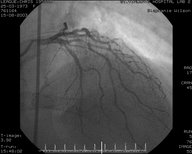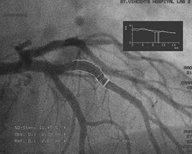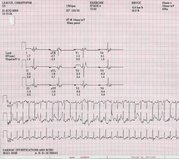
An annotated screen shot from the computer in the cardiac cath lab.

Here, the computer has estimated the shape of an artery where
constricted blood flow can be seen. The measurement shows that 51% of
the 1.96mm diameter is blocked; this is a 76% blockage in area.

This is the worst—a 93% blockage.

An 89% blockage in another branch of the same artery.

Success—you can see from the branching pattern that this is the same
artery that has an 89% blockage above, but now it is down to 20%.

This is the ECG that was produced during my stress test (Bruce
protocol, stage 4).
|
At St. Vincent’s
I was examined quickly in the ER, but then had to wait around in a
gown for the better part of the day… waiting, anxiously, to hear that
I was not having a heart attack and I could go enjoy the rest of my
holiday. Unfortunately, my blood test came back with elevated
troponin, which is released into the blood stream when the heart
muscle suffers damage.
This result finally got the attention of a cardiologist, and before
long I was rushed to the cardiac cath lab for emergency angiography…
they guided a catheter into my femoral artery, and maneuvered it up
into my heart, so they could X-ray and tinker with it.
Although the procedure was relatively painless, it was nevertheless
the scariest experience of my life. Especially during preparation:
they placed gel-laden orange pads on my chest, in case of cardiac
arrest. (When they carted me around for various tests, I always went
with a battery-operated EKG monitor and defibrillator…) Amidst all the
tinkering, all I could really feel was a severe hot flash whenever
they released the X-ray dye.
Anyway, it turns out I had a 93% blockage in the LAD (left anterior
descending) coronary artery. :(
Now that I’ve got you on the edge of your seat, I’ll cut the story
short with the good news. As part of the same procedure, still
working just through the femoral artery, they enlarged the bad artery
and inserted two stents—small metal scaffolds that keep it open.
Moreover, these are the new Cypher stents, that are coated with
medication to prevent them from blocking again.
The procedure was successful, and I recovered in a private room with a
view of the city, closely monitored by clever machines and helpful
nurses. Before leaving the hospital, I had an
echocardiogram (a kind of sonogram) where they determined that my
heart was now working quite well. They said it looked like the stent
was applied before much damage could occur.
For medical folks and fellow nerds, the technical diagnosis was “very
mild anteroseptal hypokinesis, left ventricular ejection fraction:
60%.” (Apparently, a normal ejection fraction at rest is 55–65%)
Since he knew I was a computer scientist, one of the interventional
cardiologists burned for me a CD-ROM of the pictures and movies they
took during angiography. You can see the results on this page. (I’m
also thrilled to report I was able to extract and process the DICOM
medical image format using entirely open-source tools on Linux, specifically MedCon and ImageMagick.)
Prognosis
I left the hospital, and slowly resumed tourism. Before leaving
Sydney though, I had another test that gave me much more confidence:
an echocardiogram after spending 10 closely-monitored minutes
power-walking and jogging on a treadmill, which brought my heart rate
to 196 bpm. The cardiologist said my heart looked relatively healthy,
and that I should resume (i.e., start) exercise.
We then flew from Sydney to Melbourne, and had a relatively normal last
5 days of ‘vacation’. Now I’m safely back in New York, and I’m taking
blood thinners, blood pressure meds, cholesterol meds, etc. But I’m
really feeling much better.
I haven’t exactly worked out yet the philosophical implications of
being by far the youngest patient in the cardiac ward, and what that
means for my life expectancy. But all signs seem to indicate that, if
I manage my risk factors well, I should be fine. In balance, it might
even be good that I had this early ‘warning’.
|













